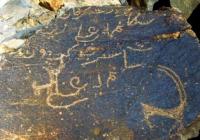Вы здесь
Petroglyphs of Soy Sabag.

Monuments Sogd of province.
“If an ancient man saw planes two thousand years ago
He would've thought they were birds
Or angels from another world
Or messengers from other planets”
Dejan Stojanovic.
Excursion tours over monuments of Northern Tajikistan.
The concentration of petroglyphs is located in the mountains Mathca District in the Sogd Province of the Republic of Tajikistan. The Soy Sabag Gorge is on the southern slope of the Turkestan Range. A mountain river, the Soy Sabag, a right tributary of the Zeravshan River, follows the bottom of the gorge.
A concentration of petroglyphs is located at the mouth of the gorge near foothills to the west of the village of Sabag, on the eastern slope of a desolate gorge. Soy Sabag is at an altitude of 2,327m, between 39 28 07.6 of northern latitude and 69 47 57.9 of eastern longitude (Bobomulloev 2010).
The rock art is located along the road connecting Sabag and a high-altitude upper village of the Matcha District. Some engraved surfaces are even visible from the road. Level of Study Biologists Vorontsov N.N. and Lyapunova E.A. (1976: 101 – 109) discovered the petroglyphs when they visited the gorge on July 13, 1973.
They examined and photographed them on 18 rocks and traced some images on paper. They studied the pecked images at Soy Sabag only from a faunistic perspective assuming that this concentration of petroglyphs had been well-known to archeologists.
Nevertheless, they attempted to date them on the basis of stylistic differences and the intensiveness of their patina, identifying three stylistic periods: the most ancient in a realistic style, the medium one with linear sketchy drawings, and later images made in “loophole”, “geometric”, and “rectangular” styles. In 2009, Soy Sabag was surveyed by an expedition from the Akhmad Donish Institute of History Archeology and Ethnography under the AS of the RT led by Bobomulloev B.S., within a regional project for the preparation of the serial trans-boundary nomination to the World Heritage List of UNESCO.
Field work resulted in basic documentation of the site: a map of the location of surfaces with petroglyphs, indexed photo panoramas, photos of 122 surfaces and their fragments, copies of individual surfaces with petroglyphs.
Main Substrate of Rock Art Petroglyphs are pecked on smooth rock surfaces and are covered with a brownish-black patina. Description of the Site The Soy Sabagh petroglyphs are very compact. The total area of distribution of images is more than 0.5 ha.
Three groups (clusters) of petroglyphs differing in location were identified. The surfaces were numbered from the bottom up and from left to right.
Of Petroglyphs Soy Sabag total, about 1,000 petroglyphs on 122 surfaces grouped into three classes were registered.
Group 1 of Petroglyphs Soy Sabag. Eight surfaces were identified with 19 isolated images - mostly of mountain goats, carved in a "linear" style. All the ancient petroglyphs in this group were retouched at a later time.
Group 2 of Petroglyphs Soy Sabag. A total of 45 surfaces with petroglyphs were registered; the total number of images is about 150 and includes 16 groups. As in the first group of petroglyphs these are mostly mountain goats; humans, archers, horse riders with bows and arrows, hunting scenes, horses; Bronze Age carts were found three times; two inscriptions are in Arabic script. Few images have been retouched.
Group 3 of Petroglyphs Soy Sabag. Petroglyphs of the third group, in turn, are divided into two subgroups, 3a and 3b. More than 540 petroglyphs were found on 68 surfaces.
In group 3a, most petroglyphs are in scenes.
There are many images of bulls (urus), wheels, mirrors with a side handle and wave-like characters absent from Groups 1 and 2. Group 3b has goats, bulls, archers, horse riders, mirrors, wave-like symbols, spiral marks and signs in a circle. The drawings often overlap one another. Most drawings represent scenes.
Images were made by pecking with a sharp metal tool. Techniques are diverse, with linear, contour, silhouette, contour-linear, and linear silhouette images. Dating The oldest period of images at Soi Sabagh includes chariots, bulls (Bos primigenius), spectacleshaped signs, different graphics and wavy figures of the Bronze Age, IIIrd – IInd millennia BC.
During the excavation of the settlement of Sarazm, the bone remains of a wild bull and a cylindrical seal with the depiction of a bull were unearthed. Analysis showed that sodalite found during the Sarazm excavations comes from deposits of semi-precious gemstones in the upper reaches of Sabagh Gorge (Razzakov 1997, 2008).
Quite a few images carved in the Saki “animalistic style” are dated to the Early Stone Age. Images related to the Middle Ages are isolated. In groups 1 and 2, drawings were renovated in medieval and modern times.
Authority:
Bobomullo S. Bobomulloev.
Photos by
Surat Toymasov.







